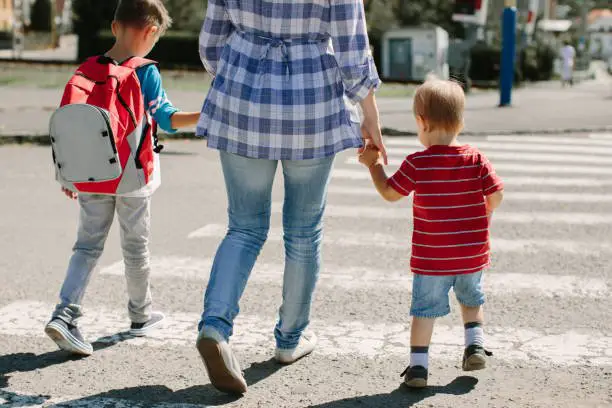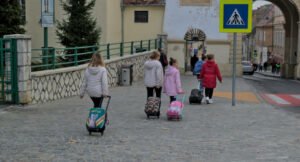Safe Routes to Schools Grants – A Comprehensive Guide 2024.

Have you been thinking of how to access Safe Routes to Schools grants for enhancing student safety and promoting active transportation? Learn about eligibility criteria, application process, and funding opportunities for implementing safer routes in your community with our comprehensive guide.
Safe Routes to School (SRTS) advocates for walking and biking to school by enhancing infrastructure, enforcement, education, and incentives. Nationally, 10%–14% of morning rush hour trips are for school travel, highlighting the significance of SRTS initiatives in improving student safety and physical activity levels. These programs can be implemented by various entities, including departments of transportation, metropolitan planning organizations, local governments, school districts, or individual schools. Valuable resources, such as the SRTS Guide, parent surveys, student tallies, and strategies like the walking school bus, are available through a national center to support biking and walking initiatives in schools.

Safe Routes to School Grants
Planning Assistance grants
Funding is provided to schools and communities for the development of comprehensive Safe Routes to School (SRTS) plans. These plans are crafted either by regional development organizations or a statewide SRTS consultant, ensuring a thorough approach to promoting safe and active transportation for students.
This assistance helps in conducting thorough assessments, gathering community input, identifying infrastructure improvements, and establishing strategies to promote active transportation to school. By leveraging these grants, schools, and communities can create comprehensive SRTS plans tailored to their specific needs and circumstances, ultimately fostering safer and healthier environments for students.
Here are some key details about planning assistance grants:
1. Purpose: Planning assistance grants are aimed at helping communities establish or enhance their SRTS programs by developing strategic plans that focus on improving safety and accessibility for students who walk or bike to school.
2. Scope of Projects: These grants may cover a wide range of planning activities, including:
- Conducting assessments of existing walking and biking conditions around schools
- Engaging stakeholders and community members in the planning process
- Analyzing data related to student transportation habits, safety concerns, and infrastructure needs
- Identifying priority areas and routes for infrastructure improvements
- Developing comprehensive SRTS plans that outline strategies for promoting walking and biking to school, addressing safety issues, and implementing infrastructure and non-infrastructure projects.
3. Applicants: Planning assistance grants may be available to various entities, including school districts, local governments, transportation agencies, nonprofit organizations, and community groups. Eligibility criteria and application requirements vary depending on the funding source and administering agency.
4. Collaboration: Successful planning assistance grant applications often involve collaboration between multiple stakeholders, such as schools, transportation agencies, public health departments, community organizations, and parent groups. Engaging diverse stakeholders ensures that the resulting plans reflect the needs and priorities of the entire community.
5. Technical Assistance: In addition to financial support, planning assistance grants may offer access to technical assistance and resources to help applicants navigate the planning process. This may include training workshops, webinars, guidance documents, and access to SRTS planning tools and templates.
6. Implementation Pathway: While planning assistance grants focus primarily on the development of SRTS plans, they often serve as a critical first step toward implementing infrastructure and non-infrastructure projects in the future. A well-developed SRTS plan provides a roadmap for prioritizing and implementing improvements to make walking and biking to school safer and more accessible for students.
Planning assistance grants play a vital role in supporting communities as they work to establish or enhance their Safe Routes to School programs, ultimately promoting healthier, safer, and more sustainable transportation options for students.
District Coordinator Grants
This initiative will fund coordinator positions within individual schools or districts. These coordinators will assist communities with established Safe Routes to School (SRTS) plans or other comprehensive strategies aimed at promoting safe, convenient, and enjoyable walking and biking routes for students.
District coordinator grants provide funding to support designated coordinator positions within school districts. These coordinators play a crucial role in facilitating and advancing Safe Routes to School (SRTS) initiatives at a district-wide level. Their responsibilities typically include:
1. Program Coordination: District coordinators oversee the implementation of SRTS programs across multiple schools within the district. They coordinate with school administrators, teachers, parents, and community stakeholders to ensure consistent and effective program delivery.
2. Resource Allocation: Coordinators manage budgetary resources allocated for SRTS activities within the district. They identify funding opportunities, allocate funds appropriately, and ensure efficient use of financial resources to support program objectives.
3. Training and Support: District coordinators provide training and support to school-based SRTS coordinators and volunteers. They organize workshops, seminars, and informational sessions to educate stakeholders on best practices for promoting safe walking and biking to school.
4. Community Engagement: Coordinators foster partnerships with local governments, transportation agencies, community organizations, and advocacy groups to strengthen SRTS efforts. They engage community members in planning and implementing infrastructure and non-infrastructure projects aimed at improving pedestrian and bicycle safety around schools.
5. Evaluation and Reporting: Coordinators monitor and evaluate the effectiveness of SRTS programs within the district. They collect data, conduct surveys, and analyze outcomes to assess program impact and identify areas for improvement. They also prepare reports and presentations to communicate program results to stakeholders and funding agencies.
District coordinator grants enable schools and districts to establish dedicated leadership positions focused on promoting safe and active transportation options for students, contributing to healthier and more sustainable communities.

SEE MORE: School Security System Grants for Enhanced Safety 2024.
SRTS Boost Grants
Our grant is designed to assist communities already equipped with established plans or employing comprehensive Safe Routes to School (SRTS) strategies. The focus is on promoting both infrastructure and non-infrastructure projects aimed at ensuring the safety, convenience, and enjoyment of walking and biking to school for students.
These grants typically target both infrastructure and non-infrastructure projects and are available at various levels, including federal, state, and local.
1. Infrastructure Projects: SRTS grants often fund the construction or improvement of infrastructure elements such as sidewalks, crosswalks, bike lanes, bike racks, signage, traffic calming measures, and pedestrian bridges. These projects aim to create safer and more convenient routes for students to walk or bike to school.
2. Non-Infrastructure Projects: In addition to physical improvements, SRTS grants also support non-infrastructure initiatives focused on education, encouragement, enforcement, and evaluation. These projects may include educational programs on pedestrian and bicycle safety, walking school buses, bike trains, traffic safety patrols, promotional events, and safety campaigns.
3. Prioritization of Routes: SRTS grants prioritize routes to schools based on factors such as safety concerns, existing infrastructure, proximity to schools, and student population demographics. These prioritized routes guide the allocation of funds to ensure that resources are directed where they are most needed.
4. Application Process: The application process for SRTS grants typically involves submitting a proposal outlining the proposed projects, budget, timeline, and expected outcomes. Applicants may be required to demonstrate community support, collaboration with relevant stakeholders, and alignment with SRTS goals and objectives.
5. Evaluation and Reporting: Recipients of SRTS grants are often required to evaluate the effectiveness of their projects and report on outcomes such as changes in walking and biking rates, safety improvements, and community engagement. This evaluation helps to measure the impact of the grants and inform future funding decisions.
SRTS grants play a crucial role in promoting active transportation, improving pedestrian and bicycle safety, and creating healthier and more sustainable communities for students and families.
State-Funded SRTS Infrastructure Grants
Statewide, communities can access grants to build infrastructure aimed at enhancing accessibility and safety along prioritized routes to and around schools. Previous grant projects have encompassed initiatives such as constructing sidewalks leading to schools, developing trails adjacent to state highways, and enhancing crossings along designated school walking routes. While it is recommended to have a Safe Routes to School (SRTS) plan in place before applying for these grants, no funding match is required, making the application process more accessible to interested communities.
Here are some key aspects of these grants:
1. Objective: The primary objective of state-funded SRTS infrastructure grants is to support the construction or improvement of physical infrastructure elements that facilitate safe walking and biking for students traveling to and from school.
2. Infrastructure Projects: These grants typically fund a variety of infrastructure projects, including but not limited to:
- Construction or repair of sidewalks and pathways
- Installation of crosswalks, pedestrian signals, and traffic calming measures
- Creation of bike lanes or shared-use paths
- Installation of bike racks and other bicycle parking facilities
- Improvements to intersections and crossings near schools
3. Prioritization: State governments often prioritize projects based on factors such as safety concerns, existing infrastructure deficiencies, proximity to schools, and anticipated impact on student walking and biking rates.
4. Application Process: The application process for state-funded SRTS infrastructure grants varies by state but generally involves submitting a detailed proposal outlining the proposed projects, budget, timeline, and expected outcomes. Applicants may need to demonstrate community support, collaboration with relevant stakeholders, and alignment with state SRTS goals and priorities.
5. Funding Allocation: State governments allocate funds for SRTS infrastructure grants through various mechanisms, such as dedicated funding streams, competitive grant programs, or formula-based distribution based on population or need.
6. Reporting and Evaluation: Recipients of state-funded SRTS infrastructure grants are typically required to report on the progress and outcomes of their projects, including changes in walking and biking rates, safety improvements, and community engagement. This evaluation helps state governments assess the effectiveness of the grants and make informed decisions about future funding allocations.
State-funded SRTS infrastructure grants play a crucial role in improving pedestrian and bicycle infrastructure, promoting active transportation, and creating safer and healthier environments for students and communities across the state.
Greater Minnesota Transportation Alternative
Safe Routes to School (SRTS) is an eligible program under the Transportation Alternatives Solicitation. Communities in Greater Minnesota are eligible to participate in this competitive infrastructure program. It is recommended that applicants have an SRTS plan in place before applying, and a 20 percent funding match is required for successful projects.
The Greater Minnesota Transportation Alternative (GMTA) program is a funding initiative designed to support transportation projects that enhance mobility, safety, and accessibility in rural areas of Minnesota. Here are some key aspects of the GMTA program:
1. Funding Source: The GMTA program is funded through federal transportation funds allocated to the state of Minnesota. These funds are specifically designated for projects that provide transportation alternatives to traditional highway construction and maintenance.
2. Eligible Projects: The GMTA program supports a wide range of transportation projects, including but not limited to:
- Safe Routes to School (SRTS) initiatives
- Pedestrian and bicycle infrastructure improvements
- Recreational trails and facilities
- Historic preservation of transportation-related structures
- Streetscaping and beautification efforts
- Transit enhancements
- Safe crossings for non-drivers, such as pedestrians and bicyclists
3. Geographic Focus: The GMTA program specifically targets rural areas of Minnesota outside the Twin Cities metropolitan area. These areas, often referred to as Greater Minnesota, include smaller cities, towns, and rural communities.
4. Competitive Selection Process: Projects seeking funding through the GMTA program must go through a competitive selection process. Applicants submit proposals detailing their project’s scope, objectives, budget, and expected outcomes. Projects are evaluated based on criteria such as safety, connectivity, community support, and alignment with program goals.
5. SRTS Emphasis: Safe Routes to School (SRTS) projects are one of the eligible categories under the GMTA program. These projects aim to improve safety and encourage walking and biking to school for students in rural communities. Funding may support infrastructure improvements such as sidewalks, crosswalks, bike lanes, and traffic calming measures.
6. Funding Match: Projects selected for funding through the GMTA program typically require a matching contribution from the project sponsor. The match requirement varies depending on the project type and funding source but is generally a percentage of the total project cost.
The Greater Minnesota, Transportation Alternative program, plays a vital role in supporting transportation projects that enhance the quality of life and promote sustainable mobility options in rural communities across Minnesota.

Conclusion on Safe Routes to Schools Grants.
Safe Routes to School (SRTS) grants provide valuable funding opportunities for communities, schools, and organizations to enhance the safety and accessibility of walking and biking routes for students. These grants support a wide range of infrastructure and non-infrastructure projects aimed at promoting active transportation, improving student health, and creating safer communities.
By investing in SRTS initiatives, stakeholders can contribute to healthier, more sustainable, and more vibrant neighborhoods where students can thrive. With the availability of resources, guidance, and support, communities can leverage SRTS grants to make meaningful improvements that benefit students, families, and the broader community.
Frequently asked questions
What are Safe Routes to School (SRTS) grants?
SRTS grants are funding opportunities aimed at supporting initiatives that improve safety and accessibility for students who walk or bike to school.
Who can apply for SRTS grants?
Eligibility for SRTS grants varies depending on the funding source and administering agency. Typically, schools, school districts, local governments, transportation agencies, nonprofit organizations, and community groups are eligible to apply.
What types of projects do SRTS grants fund?
SRTS grants may fund a variety of projects, including infrastructure improvements (e.g., sidewalks, crosswalks, bike lanes) and non-infrastructure initiatives (e.g., educational programs, promotional events) that encourage walking and biking to school.
Are there specific requirements for applying for SRTS grants?
Requirements for applying for SRTS grants vary depending on the funding source and program guidelines. However, applicants may be required to demonstrate community support, collaborate with relevant stakeholders, and align their proposed projects with SRTS goals and objectives.
Is there a match requirement for SRTS grants?
The match requirement for SRTS grants varies depending on the funding source and program guidelines. Some grants may require a matching contribution from the applicant, while others may not have a match requirement.
How can I find out about available SRTS grants?
Information about available SRTS grants can typically be found on the websites of relevant government agencies, such as state departments of transportation or education. Additionally, organizations dedicated to promoting active transportation and safe walking and biking may provide updates on grant opportunities.
What resources are available to help with applying for SRTS grants?
Resources to help with applying for SRTS grants may include guidance documents, application templates, technical assistance, and training workshops provided by government agencies, nonprofit organizations, and SRTS advocacy groups.
How are SRTS grant applications evaluated?
SRTS grant applications are typically evaluated based on criteria such as project need, feasibility, community support, alignment with program goals, and potential impact on student safety and physical activity levels.
What happens after a grant application is approved?
After a grant application is approved, recipients are typically required to enter into a grant agreement with the funding agency and proceed with project implementation according to the proposed timeline and budget. Recipients may also be required to submit progress reports and comply with reporting requirements throughout the grant period.
Where can I get more information about SRTS grants?
For more information about SRTS grants, including available funding opportunities, eligibility criteria, application guidelines, and resources, interested parties can contact relevant government agencies, visit official websites, and reach out to SRTS advocacy organizations for assistance.

